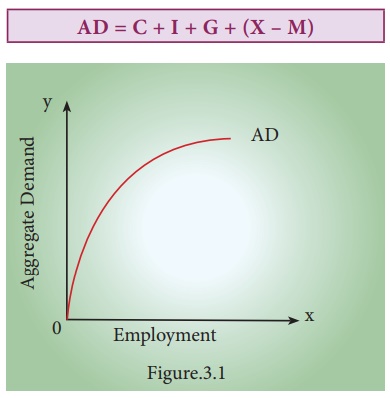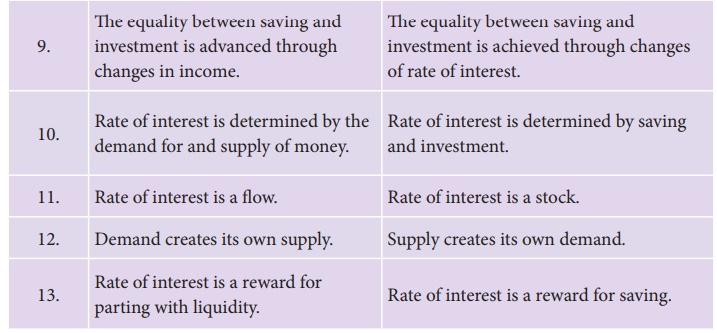Theories of Employment and Income in Economics - Effective Demand | 12th Economics : Chapter 3 : Theories of Employment and Income
Chapter: 12th Economics : Chapter 3 : Theories of Employment and Income
Effective Demand
Effective Demand
The starting point of Keynes theory of employment and income is
the principle of effective demand. Effective demand denotes money actually
spent by the people on products of industry. The money which entrepreneurs
receive is paid in the form of rent, wages, interest and profit. Therefore
effective demand equals national income.

An increase in the aggregate effective demand would increase the
level of employment. A decline in total effective demand would lead to
unemployment. Therefore, total employment of a country can be determined with
the help of total demand of a country.
According to the Keynes theory of employment, ŌĆ£Effective demand
signifies the money spent on consumption of goods and services and on
investment. The total expenditure is equal to the national income, which is
equivalent to the national outputŌĆØ. The relationship between employment and
output of an economy depends upon the level of effective demand which is
determined by the forces of aggregate supply and aggregate demand.
ED = Y = C + I = Output = Employment
Effective demand determines the level of employment in the
economy. When effective demand increases, employment will increase. When
effective demand decreases, the level employment will decline. The effective
demand will be determined by two determinants namely consumption and investment
expenditures. The consumption function depends upon income of the people and
marginal propensity to consume. According to Keynes, if income increases,
consumption will also increase but by less than the increase in income.
The rate of interest and marginal efficiency of capital determine
the investment levels. Rate of interest depends on money supply and liquidity
preference. Keynes has given importance to the concept of liquidity preference.
Liquidity preference is based on three motives namely transaction motive,
precautionary motive and speculative motive. MEC depends on two factors namely
Prospective yield of capital asset and supply price of capital.
(For more details see Chapter 4)
1. Aggregate Demand Function (ADF)
In the Keynesian model, output is determined mainly by aggregate
demand. The aggregate demand is the amount of money which entrepreneurs expect
to get by selling the output produced by the number of labourers employed.
Therefore, it is the expected income or revenue from the sale of output at
different levels of employment.
Aggregate demand has the following four components:
1. Consumption demand
2. Investment demand
3. Government expenditure and
4. Net Export ( export ŌĆō import )
The desired or planned demand (spending) is the amount that
households, firms, the governments and the foreign purchasers would like to
spend on domestic output. In other words, desired demand in the economy is the
sum total of desired private consumption expenditure, desired investment
expenditure, desired government spending and desired net exports (difference
between exports and imports). Thus, the desired spending is called aggregate
spending (demand), and can be expressed as:
AD = C + I + G + (X ŌĆō M)

Figure 3.1. explains that aggregate demand price increases or
decreases with an increase or decrease in the volume of employment. Aggregate
demand curve increases at an increasing rate in the beginning and then
increases at a decreasing rate. This shows that as income increases owing to
increase in employment, expenditure of the economy increases at a decreasing
rate.
2. Aggregate Supply Function (ASF)
Aggregate supply function is an increasing function of the level
of employment. Aggregate supply refers to the value of total output of goods
and services produced in an economy in a year. In other words, aggregate supply
is equal to the value of national product, i.e., national income.
In other words, the aggregate supply refers to the required amount
of labourers and materials to produce the necessary output. Employers hire
labourers, purchase various inputs and raw materials to produce goods. Thus,
production involves cost. If revenue from the sale of output produced exceeds
the cost of production at a given level of employment and output, the
entrepreneur would be encouraged to employ more labour and other inputs to
produce more.
Aggregate supply price is the total amount of money that all
entrepreneurs in an economy expect to receive from the sale of output produced
by given number of labourers employed. The term ŌĆśpriceŌĆÖ refers to the amount of
money received from the sale of output (sales proceeds). Hence, there are
different aggregate prices for different levels of employment.
The components of aggregate supply are :
1. Aggregate (desired) consumption expenditure (C)
2. Aggregate (desired) private savings (S)
3. Net tax payments (T) (Total tax payment to be
received by the government minus
transfer payments, subsidy and interest payments to be incurred by the
government) and
4. Personal (desired) transfer payments to the foreigners (Rf)(eg.
Donations to international relief efforts)
Aggregate Supply = C + S + T + Rf = Aggregate income generated
in the economy
The following figure 3.2 shows the shape of the two aggregate
supply curves drawn for the assumption of fixed money wages and variable wages.
AGGREGATE SUPPLY CURVE

Z curve is linear where money wages remains fixed; Z1 curve is non - linear
since wage rate increases with employment. When full employment level of Nf is
reached it is impossible to increase output by employing more men. So aggregate
supply curve becomes inelastic (Vertical straight line).
The slope of the aggregate supply curve depends on the relation
between the employment and productivity. The capital stock is often fixed and
hence the law of diminishing marginal returns takes place as more workers are
employed. Based upon this relation, the aggregate supply curve can be expected
to slope upwards. In reality the aggregate supply curve will be like Z1 in
figure 3.2. Therefore, the aggregate supply depends on the relationship between
price and wages. If prices are high and wages low, the producers will try to
employ labourers. If prices are low and wages high, investment will be
curtailed, output will fall and there will be a reduction in the productive
capacity. Thus aggregate supply is an important factor in determining the level
of economic activity.
3. Equilibrium between ADF and ASF
Under the Keynes theory of employment, a simple two sector economy
consisting of the household sector and the business sector is taken to
understand the equilibrium between ADF and ASF. All the decisions concerning
consumption expenditure are taken by the individual households, while the
business firms take decisions concerning investment. It is also assumed that
consumption function is linear and planned investment is autonomous.

There are two approaches to determination of the equilibrium level
of income in Keynesian theory. These are :
1. Aggregate demand ŌĆō Aggregate supply approach
2. Saving ŌĆō Investment approach
In this chapter, out of these two, aggregate demand and aggregate
supply approach is alone explained to understand the determination of
equilibrium level of income and employment.
The concept of effective demand is more clearly shown in the
figure 3.3
In the figure, the aggregate demand and aggregate supply reach
equilibrium at point E. The employment level is No at that point.
At ON1 employment, the aggregate supply is N 1 R1 . But they are able to
produce M1 N1. The expected level of
profit is M1 R1. To attain this level of profit, entrepreneurs will employ more
labourers. The tendency to employ more labour will stop once they reach point
E. At all levels of employment beyond, ONo, the aggregate demand curve is below the
aggregate supply curve indicating loss to the producers. Hence they will never
employ more than ONo labour. Thus effective demand concept becomes a crucial point in
determining the equilibrium level of output in the capitalist economy or a free
market economy in the Keynesian system.
It is important to note that the equilibrium level of employment
need not be the full employment level (N1) from the Figure 3.3, it is understood that the
difference between No ŌĆō Nf is the level of unemployment. Thus the concept of effective
demand becomes significant in explaining the under employment equilibrium.


Related Topics